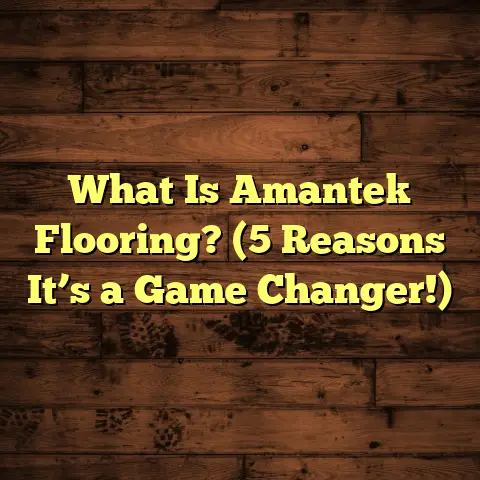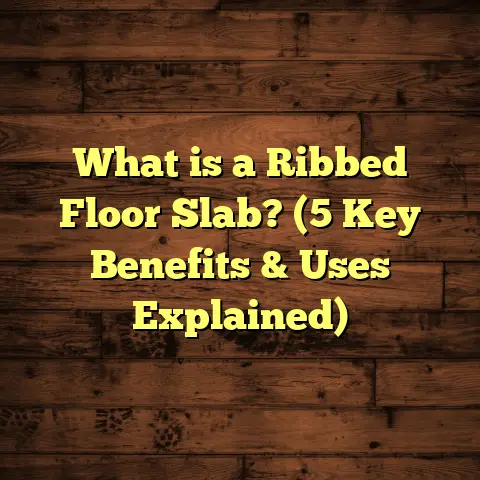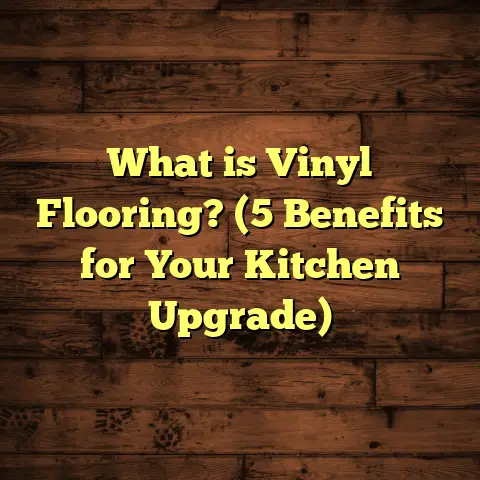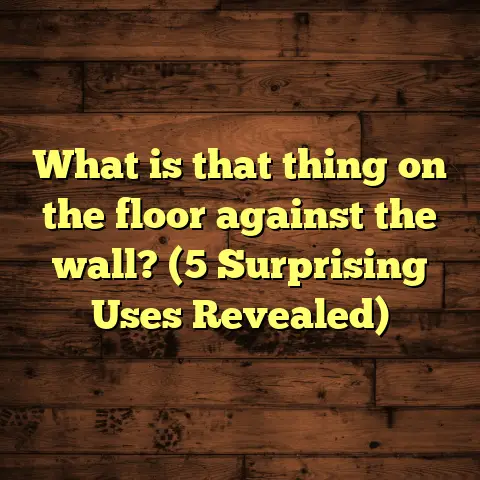What is Parquet Flooring? (5 Unique Benefits for Your Home)
Luxury in a home often starts from the ground up. When I think about floors that bring a sense of refined elegance and warmth, parquet flooring immediately comes to mind. There’s something uniquely sophisticated about the way the wood pieces fit together in intricate patterns, telling stories of craftsmanship and timeless design. The moment you step into a room with parquet floors, it feels like you’re in a space that’s been carefully curated—not just for looks, but for comfort and lasting beauty.
For me, luxury isn’t just about flashy finishes or expensive decorations; it’s about quality that stands the test of time. Parquet flooring embodies this philosophy perfectly. It’s a flooring choice that combines art and engineering in a way few others do. Over the years working as a flooring contractor, I’ve seen how parquet transforms rooms, adding character and value. Let me walk you through what parquet flooring really is and why it might be the perfect choice for your home.
What Is Parquet Flooring?
Parquet flooring is essentially a form of hardwood flooring made from small pieces of wood arranged in decorative geometric patterns. Unlike traditional hardwood floors where long planks are laid parallel to each other, parquet is all about design and craftsmanship. The pieces—often called blocks or tiles—are cut into shapes like squares, rectangles, triangles, or parallelograms and then assembled into patterns like herringbone, chevron, basket weave, or even intricate mosaics.
The term “parquet” comes from the French word parchet, which means “small enclosed space,” reflecting how these tiny wooden blocks fit together like a puzzle to create decorative surfaces.
A Little History
Parquet flooring has roots that go back centuries. It first gained prominence in 17th-century France, where it was used in royal palaces such as the Palace of Versailles. Back then, parquet replaced marble floors because it required less maintenance and was warmer underfoot—two advantages that still hold true today.
The designs were originally very ornate, reflecting the lavish tastes of European aristocracy. Over time, parquet has evolved but still holds onto its reputation for elegance and craftsmanship.
How Parquet Is Made
Most parquet flooring is made from solid hardwoods like oak, walnut, maple, cherry, or mahogany. The choice of wood affects not only the look but also the durability and cost.
The wood pieces are precision-cut into specific shapes and then assembled into patterns before being glued or nailed down onto the subfloor during installation. Some modern parquet floors come in preassembled tiles or panels to speed up installation.
In my early years working in flooring, I remember how much care it took to get each pattern just right. Every piece had to be aligned perfectly—any misalignment would disrupt the flow of the design and ruin the visual effect.
Solid vs Engineered Parquet
Parquet floors can be made from solid wood blocks or engineered wood (layers of wood veneer over plywood). Solid parquet is more traditional and can be sanded and refinished multiple times over decades. Engineered parquet tends to be more stable against moisture changes and easier to install in spaces like basements.
When I advise homeowners on choosing between these types, I usually lean towards solid parquet for main living spaces where longevity matters most. But engineered parquet is a great option if you have a moisture-prone area or want a quicker installation.
5 Unique Benefits of Parquet Flooring for Your Home
Now that we’ve covered what parquet flooring is, let’s get into why it’s such a fantastic option for your home. Over my career, I’ve seen hundreds of homeowners amazed by these five benefits.
1. Timeless Elegance That Never Goes Out of Style
One reason I love parquet floors so much is their classic aesthetic. Unlike some flooring styles that come and go with trends, parquet has been admired for generations. It carries an inherent sense of sophistication because it draws on centuries-old design traditions.
For example, the herringbone pattern—a favorite among my clients—is visually striking but subtle enough to fit with both modern and traditional décor. I installed herringbone parquet in a client’s living room last year who had a mid-century modern theme going on. The flooring added warmth without clashing with their sleek furniture.
Did you know? According to the National Wood Flooring Association’s 2023 survey:
- 68% of homeowners who installed parquet reported an increase in their home’s resale value within two years.
- Homes with parquet floors tend to spend less time on the market compared to those with standard vinyl or laminate floors.
This type of flooring sends a message: quality matters here. And because it’s so adaptable in style—from rustic oak blocks to glossy walnut mosaics—it fits almost any interior design.
2. Versatility in Design Options
If you enjoy expressing personality through your home’s interior, parquet can be like a blank canvas for creativity.
Have you ever looked closely at different parquet patterns? Beyond the popular herringbone and chevron layouts, there are basket weave, brick pattern, Versailles pattern (which mimics old French palace floors), and even custom mosaic designs.
One project that stands out for me was a boutique hotel lobby where the manager wanted something bold but classy. We combined walnut and maple blocks to create a checkerboard pattern with diagonal stripes running through it. Guests kept complimenting how unique and inviting the floor looked.
The ability to mix wood types also lets you play with color contrasts—light maple alongside dark walnut can create stunning visual effects without additional paint or wallpaper.
Here’s an insight: Because parquet uses smaller wood pieces arranged artistically, it works well in both large open spaces and smaller rooms where you want to add character without overwhelming the eye.
3. Durability Backed by Solid Hardwood
Durability is one of my main selling points when recommending any hardwood floor—and parquet excels here too.
Many people assume intricate floors are fragile—but solid hardwood parquet can handle heavy foot traffic just as well as traditional plank floors. This is because each block is typically thicker than laminate or vinyl tiles and made from dense hardwood species.
I installed solid oak parquet in a busy café a few years ago. Despite daily foot traffic from dozens of customers plus occasional spills, the floor remained beautiful with minimal wear signs after three years.
Scientific angle: Hardwood floors can be refinished multiple times—up to 7 times on average according to industry studies—allowing you to sand out scratches or dents rather than replacing the floor entirely.
This longevity means parquet flooring is an investment that pays dividends over decades.
4. Easy Maintenance and Repair
You might wonder if those small wood blocks make cleaning tricky or repairs complicated. Actually, I’ve found parquet to be surprisingly manageable.
Routine maintenance is simple: regular sweeping or vacuuming keeps dust away; damp mopping with mild wood cleaner removes stains while protecting the finish.
What really sets parquet apart is how easy repairs are compared to full plank floors. If a section gets damaged—a scratch from furniture or pet nails—you can replace individual blocks instead of ripping up the entire floor.
One memorable repair job involved a client whose dog scratched several blocks near the entrance. We swapped out just those pieces within hours without disturbing surrounding wood or needing a full refinish.
Cost note: According to HomeAdvisor data:
- Partial repairs on parquet typically cost 30-50% less than full floor replacements.
- This makes parquet practical for families or active households wanting durable yet easy-to-fix floors.
5. Improved Indoor Air Quality
An often overlooked benefit of parquet (and hardwood floors generally) is their contribution to healthier indoor air quality.
Unlike carpets which trap dust mites, pollen, pet dander, and other allergens inside fibers—wood floors don’t hold onto these irritants as much. This makes cleaning more effective and reduces allergy triggers indoors.
I’ve worked with several clients who switched from wall-to-wall carpet to hardwood parquet specifically because they or their children suffered from asthma or allergies.
Supporting research: The Asthma and Allergy Foundation recommends hard surface flooring such as hardwood because:
- They reduce allergen accumulation by up to 60% compared to carpets.
- They improve overall air circulation by not trapping particles in fibers.
So if you want beautiful floors and better health outcomes for your family, parquet is definitely worth considering.
What I’ve Learned Installing Parquet Floors Over the Years
Every job teaches me something new about how these floors interact with homes and lifestyles.
One project remains close to my heart—a Victorian house restoration where original 19th-century parquet was beyond repair due to water damage. We sourced reclaimed hardwood blocks matching the original species and pattern exactly. Using traditional installation methods (like hand nailing rather than glue), we managed to restore both beauty and authenticity.
The homeowners were amazed at how the restored floor maintained historic charm yet felt fresh underfoot.
Another experience involved helping a young couple pick out their first home’s flooring. They wanted something stylish but kid-friendly. We went with light maple parquet laid in chevron style which brightened their compact living room and hid dirt well thanks to natural grain patterns.
They told me later it helped them feel proud of their space every time friends visited—a reminder that floors set emotional tones too.
Technical Details & Installation Tips You Should Know
Installing parquet isn’t quite the same as laying regular hardwood planks—it demands more precision because pattern alignment affects how the entire floor looks.
Here are some things I always check before starting:
- Subfloor prep: The surface must be flat within ±3mm over 3 meters for smooth installation.
- Acclimatization: Wood blocks need at least 72 hours in the installation environment for moisture balance.
- Dry layout: I always do a dry run layout before gluing down blocks so I can adjust spacing or fix pattern errors.
- Adhesive type: Using strong adhesives suited for hardwood prevents shifting over time.
- Finishing coats: Multiple polyurethane layers protect flooring against wear while enhancing color depth.
A common mistake I see with DIY installers is rushing these steps—leading to uneven surfaces or gaps between blocks later on. That’s why professional installation matters if you want flawless results that last decades.
Budgeting Your Parquet Project: What To Expect Cost-Wise
Cost is often one of the first questions homeowners ask me about parquet flooring—and rightly so since it usually requires more investment upfront than standard options like vinyl or laminate.
Here’s a rough breakdown based on recent projects:
| Cost Element | Price Range (per sq ft) |
|---|---|
| Materials (solid hardwood) | $8 – $15 |
| Installation labor | $7 – $12 |
| Finishing & sealing | $2 – $4 |
Generally speaking, total costs fall between $15 and $27 per square foot depending on wood species chosen and complexity of pattern. Complex designs like Versailles pattern or custom mosaics push costs higher due to extra labor time.
For example, I tracked one client’s medium-sized living room project (around 300 sq ft) completed last year:
- Material cost: $3,600 (solid oak blocks)
- Installation & finishing: $1,800
- Total: $5,400 (~$18 per sq ft)
While this may seem high compared to cheaper alternatives ($3-$5 per sq ft), many clients tell me it’s worth every penny given how much value it adds aesthetically and financially over time.
How To Care For Your Parquet Floors Long-Term
Caring for parquet isn’t complicated but it does require some attention:
- Avoid water pooling: Wipe spills immediately to prevent wood damage.
- Use protective pads: Furniture pads help avoid scratches.
- Regular cleaning: Sweep daily; mop weekly with wood-safe cleaner.
- Refinishing cycles: Sanding & refinishing every 8-12 years keeps floors looking new.
- Humidity control: Maintain indoor humidity between 35%-55% to prevent wood expansion/contraction causing gaps or buckling.
I always tell clients: treat your parquet like fine furniture—you want to preserve its beauty but also enjoy its warmth day-to-day without stress.
Comparing Parquet With Other Flooring Types
Sometimes people ask me how parquet stacks up against other popular options:
| Feature | Parquet | Traditional Hardwood Planks | Laminate | Vinyl |
|---|---|---|---|---|
| Design variety | High (patterns) | Medium (plank styles) | Low | Low |
| Durability | Very high | Very high | Moderate | Moderate |
| Maintenance | Moderate | Moderate | Low | Low |
| Repairability | High (block replacement) | Medium (plank replacement) | Low | Low |
| Cost | High upfront | Moderate-high | Low | Low |
| Health benefits | High (hardwood) | High | Low (synthetic) | Low |
If you want design uniqueness and longevity along with natural materials, parquet often comes out ahead despite higher initial price.
Real Homeowner Stories That Show Parquet Benefits
Story 1: The Historic Charm
A couple bought an old farmhouse with worn-out floors but wanted to keep its rustic charm intact. We installed reclaimed oak parquet in a Versailles pattern across the main rooms which matched original trims perfectly—and they loved how this blend of old and new gave their home personality without feeling dated.
Story 2: Allergy Relief
A family with young kids suffering from allergies switched from carpeted bedrooms to maple parquet floors. Within weeks they noticed fewer allergy flare-ups thanks to easier cleaning and less trapped dust—making their home safer and more comfortable overall.
Story 3: The Bold Statement
A graphic designer wanted something bold for his urban loft living room. Choosing walnut/parquet chevron pattern gave him exactly that—a stylish floor that doubled as art complementing his minimalist décor perfectly while hiding wear from pets and constant foot traffic.
Frequently Asked Questions About Parquet Flooring
Q: Can I install parquet over radiant heating?
A: Yes! Engineered parquet works best over radiant heat due to its layered construction minimizing expansion issues. Solid wood can also work if installed properly with acclimation steps.
Q: How long does installation take?
A: For an average 300 sq ft room with standard herringbone pattern, expect about 3-5 days including subfloor prep, acclimation, installation, and finishing coats drying time.
Q: Is parquet flooring noisy?
A: Proper installation with underlayment reduces noise significantly. Unlike laminate which can sound hollow, solid wood offers warmer acoustics underfoot when installed correctly.
Q: What if my floor gets scratched?
A: Minor scratches can often be buffed out during routine refinishing every 8-12 years. For deeper damage, individual block replacement is possible without disturbing entire floor sections.
Wrapping Up My Thoughts On Parquet Flooring
If you want floors that combine artistry with practicality—and offer benefits ranging from durability and easy repairs to healthier indoor air—parquet should be high on your list.
Its timeless style means you’re investing not just in looks but in something that will age gracefully while supporting your lifestyle needs for decades ahead. Whether restoring an old home or adding personality to a new build, parquet offers unmatched flexibility in design paired with solid performance backed by hardwood’s natural strengths.
I hope my experiences and insights help you feel more confident exploring this unique flooring option for your home. Have questions about patterns or installation? Want help deciding which wood species fits your budget? Just ask—I’m here to help!





